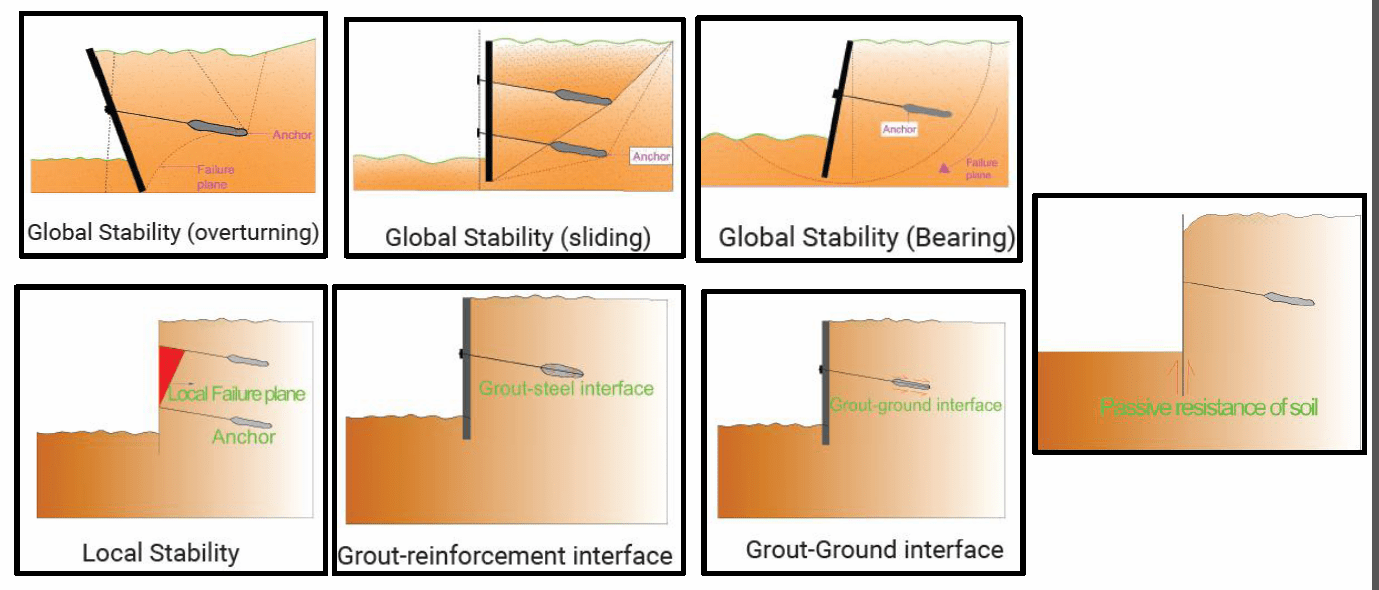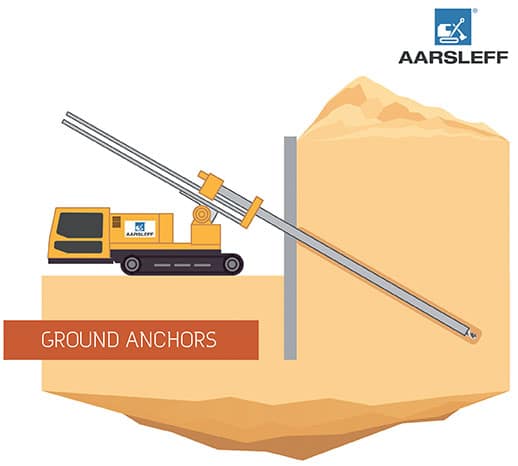Just How Heavy-Duty Earth Anchors Work: A Comprehensive Guide to Dirt Anchoring Solutions
Heavy-duty Earth supports play an important duty in providing stability and support in various construction applications. By installing deeply right into the ground, they withstand side and upright forces successfully. Different sorts of anchors deal with various dirt conditions, making them versatile. Recognizing their technicians and installation strategies is essential for maximizing efficiency. What elements affect their effectiveness, and just how do they compare to standard approaches? The answers might amaze you.
Comprehending Sturdy Earth Anchors
Sturdy Earth anchors function as important elements in numerous construction and landscape design jobs, offering stability and assistance in challenging dirt problems. These supports function by being installed right into the ground, where they resist side and vertical pressures. Their layout enables safe accessory to frameworks, ensuring they remain anchored versus dirt movement or exterior loads.The performance of heavy-duty Earth anchors mostly depends on the type of dirt and the anchor's installment deepness. Correct installation techniques are essential, as they figure out the support's holding capability. Environmental factors, such as wetness and freeze-thaw cycles, can additionally affect performance.These anchors are frequently made use of in applications varying from safeguarding fencings and preserving wall surfaces to supporting momentary structures throughout unfavorable climate condition. Comprehending the concepts behind durable Earth anchors is important for professionals looking for to boost the durability and safety of their projects.
Kinds Of Heavy-Duty Earth Anchors
Numerous types of sturdy Earth supports are developed to satisfy details needs based on soil conditions and job requirements. Helical supports, featuring screw-like blades, are effective in softer soils, using high tons capacities and very easy installment. Driven supports, which are inculcated the ground, appropriate for rocky surfaces and provide immediate lots support. Tie-back anchors are typically made use of in maintaining wall applications, permitting side assistance by securing into the ground at an angle. One more type is the cast-in-place anchor, perfect for concrete applications, as they are integrated right into foundations for enhanced stability. Dirt screw supports are versatile choices that can be used in various soil types, providing reputable stress and compression capabilities. Each type offers distinct applications, ensuring stability and safety in building and landscape design projects. Comprehending these alternatives permits informed decisions in selecting the suitable Earth securing service.
The Mechanics of Dirt Anchoring

Recognizing the technicians of dirt anchoring calls for an examination of different sorts of Earth anchors and their installment methods. Each anchor type provides one-of-a-kind characteristics that influence its efficiency in various dirt problems. Appropriate installation methods are essential for taking full advantage of the securing system's stability and efficiency.
Sorts Of Earth Anchors
Earth supports, crucial elements in soil anchoring systems, come in several kinds, each developed for certain applications and dirt problems. One of the most typical types consist of screw anchors, which are twisted right into the ground, giving strong side resistance. Helical anchors include blades that permit efficient installment in different dirt types, making them appropriate for both long-term and momentary applications. Driven supports, generally made from steel, are hammered into the dirt and are efficient in rocky or dense environments. Auger supports use a helical design to help with installation in softer dirts. Plate supports are composed of a flat plate buried flat, distributing load over a bigger location, suitable for applications needing high load capabilities in natural dirts.
Installment Techniques Described
Appropriate installation strategies are vital for the efficiency of soil anchoring systems. The process generally begins with site assessment, confirming the chosen place can support the anchor's lots. After identifying the correct anchor type, appropriate hole depth and angle should be established. The installation entails driving the support into the ground using specific tools, such as hands-on or hydraulic drivers, to achieve ideal embedment. Post-installation, tensioning the support is crucial to assure stability; this is frequently confirmed with lots testing. In addition, surrounding soil problems should be checked to avoid displacement. Following these methods not only enhances the support's performance however also lengthens its life-span, offering reputable support for various applications.
Applications of Heavy-Duty Earth Anchors
While sturdy Earth supports are commonly connected with building and construction and landscaping, their convenience encompasses a variety of applications across different sectors. In civil design, they provide essential support for keeping walls, ensuring stability in areas prone to soil disintegration. The marine sector utilizes these anchors for protecting docks and marinas, protecting against activity triggered by trends and currents. Additionally, in the telecom market, durable Earth supports are substantial for supporting cell towers and various other high structures against wind forces. Agricultural applications additionally profit, as these supports can secure structures like greenhouses and livestock fencing, ensuring they hold up against rough weather. In addition, in renewable resource projects, such as wind ranches, Earth anchors play an important role in safeguarding generator foundations, enhancing total safety and security and performance. This wide variety of applications highlights the versatility and integrity of durable Earth anchors throughout different fields.
Advantages Over Typical Anchoring Techniques
Typical anchoring techniques have long been depended upon for stability, durable Earth supports offer substantial advantages that enhance performance and performance. One significant advantage is their exceptional load-bearing capability, which allows them to stand up to better forces without failing. This stamina makes them ideal for demanding applications, such as in building and construction and energy installations.Additionally, heavy-duty Earth supports are designed for much deeper setup, offering greater stability in numerous dirt conditions, consisting of loosened or sandy soils. Their resistance to rust and ecological elements guarantees a much longer life-span and decreased maintenance prices contrasted to standard methods.Moreover, these anchors can be set up with marginal disruption to the surrounding area, preserving the stability of the landscape. Overall, heavy-duty Earth supports offer a efficient and trustworthy service for securing needs, surpassing the constraints commonly connected with standard anchoring strategies.
Installment Refine and Best Practices
The setup process for dirt anchoring services his explanation begins with thorough prep work and website evaluation to guarantee peak efficiency. Following this, a step-by-step setup overview supplies clear instructions for reliable application (heavy-duty earth anchors). Sticking to these ideal methods is crucial for attaining resilient and reliable anchoring outcomes
Prep Work and Website Analysis
Efficient preparation and detailed website evaluation are crucial steps in the installation of soil anchoring options. a fantastic read Prior to setup, the dirt kind must be analyzed to establish its bearing capability and suitability for securing. Performing a geotechnical study can offer vital details regarding soil composition, dampness degrees, and prospective ground motion. In addition, recognizing existing frameworks, vegetation, and utilities is important to prevent interference throughout installment. The location ought to be cleared of debris and challenges to assure risk-free gain access to for tools. Climate problems need to also be kept track of, as unfavorable conditions can influence both safety and security and installation efficacy. By carefully preparing the site and evaluating all relevant variables, the likelihood of effective anchor performance is substantially increased.
Step-by-Step Installation Overview
An extensive installment process is crucial for accomplishing suitable performance of soil securing solutions. The installation starts with choosing the ideal anchor kind and assuring the site is free from particles. Next, correct opening positioning is determined based on tons requirements. As soon as the place is developed, holes are pierced to the specified depth and diameter making use of the right tools. The support is after that placed into the hole, making certain it is straightened appropriately. After safeguarding the support, soil is backfilled and compacted to boost stability. It is vital to comply with supplier guidelines throughout the process. A post-installation evaluation confirms that the supports are properly positioned and functioning as intended, providing trustworthy assistance for the intended application.

Maintenance and Assessment of Earth Anchors
Normal maintenance and evaluation of Earth supports are crucial for ensuring lasting performance and security. Routine checks permit the very early detection of issues such as corrosion, loosening, or dirt movement. Assessors need to seek indicators of rust or degradation on the support components, specifically at the link points. In addition, the surrounding soil should be evaluated for disintegration or adjustments in wetness web content, which can influence support effectiveness.It is recommended to establish a regular examination timetable, preferably a minimum of annually, relying on ecological problems. During assessments, all noticeable components ought to be cleaned up to get rid of dirt or particles that can hide possible issues. Any indicators of distress, such as turning frameworks or unusual settling, need to trigger instant examination. Appropriate paperwork of inspections can assist in tracking support efficiency with time and help with prompt maintenance activities, making certain the supports remain functional and reliable.
Frequently Asked Concerns
What Materials Are Heavy-Duty Earth Anchors Generally Made From?
Heavy-duty Earth supports are normally created from durable materials such as galvanized steel or stainless steel, ensuring stamina and resistance to deterioration. These products provide resilient support and stability in different soil problems and applications.
Just How Do Soil Conditions Influence Support Performance?
Soil problems significantly influence support efficiency. Factors such as soil kind, wetness content, and compaction influence the anchor's grasp and security, with cohesive soils commonly offering better resistance than sandy or loose soils, influencing overall effectiveness.
Can Heavy-Duty Earth Anchors Be Recycled After Removal?
Sturdy Earth supports can be recycled after removal, offered they are examined check my blog for damage and wear. Correct cleansing and maintenance improve their durability, guaranteeing efficient performance in succeeding installments when problems enable risk-free reinstallation.
What Are the Ecological Influences of Using Earth Anchors?
The environmental effects of using Earth anchors include potential dirt disturbance, disruption of neighborhood ecological communities, and feasible contamination of groundwater. If used properly, their benefits usually exceed these worries, advertising stability in different applications.
Just how Do I Select the Right Support for My Project?
